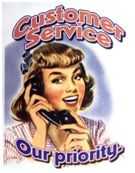|
 |
|
 |
Business success
Business success is... Satisfying customers better than competitors No customers, no business!
The 10 C’s of business success Customers, corporate culture, commitment, competence and learning, competitors, creativity and innovation, change, combination of opposites, cash and conscience - here they are!
1. Customers – amaze them!
Give customers the best possible value for money and exceed their expectations – how?
a) empathy and speed See the business from the customers' point of view and find solutions to their problems as quickly as possible.
b) customer driven 7 S’s
The last four people related S’s (sometimes called the soft S’s) are the most difficult for competitors to copy and so are particularly important.
c) cost leadership Have the lowest costs and lowest prices (if your product is similar to competitors).
d) product differentiation Selling something with a superior image and/or quality.
e) excel in the 4 P’s
f) market segmentation Selling to a particular group of customers ( a market segment or niche) e.g. rich/poor, old/young, male/female) See market segmentation.
2. Corporate culture (shared values and beliefs) Every employee must passionately believe in and act upon certain values, particularly:
See corporate culture for more detail.
3. Commitment (motivation and leadership) Happy motivated employees mean happy customers. This link is called the service-profit chain.
How do you motivate people (i.e. make them work harder and more effectively)?
See for more detail:
4. Competence and learning A successful business is a learning organization. i.e. it continually learns from its experience and mistakes with a continuously trained and educated workforce.
5. Competitors - beat them! How?
6. Creativity and innovation Creatively find new and better ways of satisfying customers (like the bagless vacuum cleaner inventor, James Dyson, pictured right). So innovation (the development of new products) and creativity (the creation of new ideas) are vital – see creativity and innovation.
7. Change All employees must continually change and adapt effectively to external changes (particularly rising expectations and different needs from customers). So employees must constantly challenge themselves and the status quo.
8. Combination of opposites The best businesses combine opposites that seem to contradict each other. Here are some examples:
9. Cash A business must always have enough cash to pay its bills by minimizing costs and maximizing sales – see cash flow management.
10. Conscience The best companies are:
Key quotes explained
“Success is a lousy teacher” - Bill Gates (pictured right) , co-founder of Microsoft. It is harder to keep a business successful than it is to make it a success. So never be complacent, always keep improving and remember that success can easily turn into failure. A passion to succeed is vital. “To be successful, you have to have your heart in your business, and your business in your heart”, said IBM’s ex-boss, Thomas Watson Snr.
“Efficiency is concerned with doing things right. Effectiveness is doing the right things”, - Peter Drucker (in his book, Management: Tasks, Responsibilities, Practices) Business success is effectiveness i.e. doing the right things really well like customer satisfaction. Efficiency is doing things at the lowest possible cost but doesn’t necessarily lead to success. Why? The wrong things might be done efficiently!
“Control your destiny or someone else will”, - Jack Welch (pictured right), ex-boss of the American company, General Electric. Take the initiative by always changing and improving customer satisfaction faster than your competitors. If you don’t, they will beat you and force you to change. Innovation is vital to satisfy future customer needs The American business professors, Gary Hamel and C.K. Prahalad, define business success as “the ability to imagine what could be” leading to the creation of new markets.
Best books
Tom Peters (pictured right) and Robert Waterman (pictured below), In Search of Excellence (1982) Business success is simple – give great customer service with great staff (KISS – keep it simple stupid!). To achieve this, the best companies do eight things: • Close to the customer - give the best possible service and quality to
customers. • Productivity through people - treating employees well so that they do their best to satisfy customers. • Hands-on, value driven – customer satisfaction is valued and prioritized by all employees including managers. • A bias for action – doing things quickly to satisfy customers. • Autonomy and entrepreneurship – encouraging innovation and giving people freedom to satisfy customers on their own or in teams (i.e. empowerment). • Sticking to the knitting - doing the business you know best e.g. McDonald's selling hamburgers. • Simultaneous loose-tight properties – a mixture of control from head office over the things that matter (like quality, customer service and the organization’s policies and objectives) and power to carry them out given to divisions, teams and individuals. • Simple form, lean staff – a simple organization structure with minimum staff at head office.
Partnerships with People (1997) A British government study which found that the best companies have
Jonas Ridderstrale (pictured right) and Kjell Nordstrom (pictured below), The Funky Business (2000) The “funky business” is successful because:
David
Packard, The HP Way (1995) The co-founder (pictured right) of the American computer and electronics company, Hewlett-Packard (HP), describes how its success was based on:
1. Simplicity - in three areas:
2. Strong commitment to people
3. Small business units Splitting up divisions when they get to a certain size (about 1500 people). |
|
|
||
|
|
|
||
|
||
| Copyright © wisdomtowin.com All Rights Reserved | ||
|



 price -
price - 












